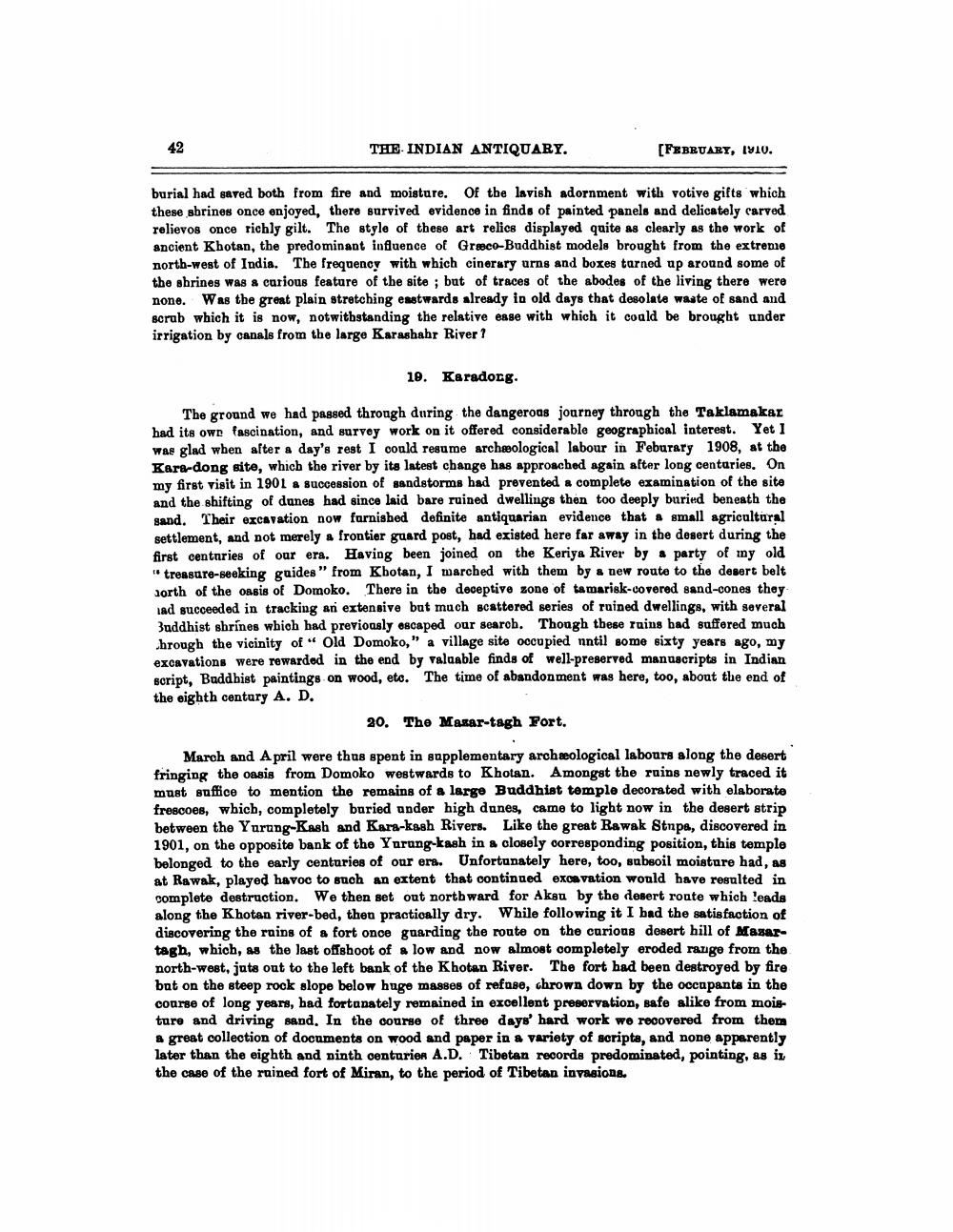________________
42
THE INDIAN ANTIQUARY.
[FEBRUARY, 1910.
burial had saved both from fire and moisture. Of the lavish adornment with votive gifts which these shrines once enjoyed, there survived evidence in finds of painted panels and delicately carved relievos once richly gilt. The style of these art relics displayed quite as clearly as the work of ancient Khotan, the predominant influence of Greco-Buddhist models brought from the extreme north-west of India. The frequency with which cinerary urns and boxes turned up around some of the shrines was a curious feature of the site; but of traces of the abodes of the living there were none. Was the great plain stretching eastwards already in old days that desolate waste of sand and scrub which it is now, notwithstanding the relative ease with which it could be brought under irrigation by canals from the large Karashahr River?
19. Karadong.
The ground we had passed through during the dangerous journey through the Taklamakar had its own fascination, and survey work on it offered considerable geographical interest. Yet 1 was glad when after a day's rest I could resume archeological labour in Feburary 1908, at the Kara-dong site, which the river by its latest change has approached again after long centuries. On my first visit in 1901 a succession of sandstorms had prevented a complete examination of the site and the shifting of dunes had since laid bare ruined dwellings then too deeply buried beneath the sand. Their excavation now furnished definite antiquarian evidence that a small agricultural settlement, and not merely a frontier guard post, had existed here far away in the desert during the first centuries of our era. Having been joined on the Keriya River by a party of my old "treasure-seeking guides" from Khotan, I marched with them by a new route to the desert belt north of the oasis of Domoko. There in the deceptive zone of tamarisk-covered sand-cones they ad succeeded in tracking an extensive but much scattered series of ruined dwellings, with several Buddhist shrines which had previously escaped our search. Though these ruins had suffered much hrough the vicinity of" Old Domoko," a village site occupied until some sixty years ago, my excavations were rewarded in the end by valuable finds of well-preserved manuscripts in Indian script, Buddhist paintings on wood, etc. The time of abandonment was here, too, about the end of the eighth century A. D.
20. The Mazar-tagh Fort.
March and April were thus spent in supplementary archaeological labours along the desert fringing the oasis from Domoko westwards to Khotan. Amongst the ruins newly traced it must suffice to mention the remains of a large Buddhist temple decorated with elaborate frescoes, which, completely buried under high dunes, came to light now in the desert strip between the Yurung-Kash and Kara-kash Rivers. Like the great Rawak Stupa, discovered in 1901, on the opposite bank of the Yurung-kash in a closely corresponding position, this temple belonged to the early centuries of our era. Unfortunately here, too, subsoil moisture had, as at Rawak, played havoc to such an extent that continued excavation would have resulted in complete destruction. We then set out northward for Aksu by the desert route which leads along the Khotan river-bed, then practically dry. While following it I had the satisfaction of discovering the ruins of a fort once guarding the route on the curious desert hill of Mazartagh, which, as the last offshoot of a low and now almost completely eroded range from the north-west, juts out to the left bank of the Khotan River. The fort had been destroyed by fire but on the steep rock slope below huge masses of refuse, chrown down by the occupants in the course of long years, had fortunately remained in excellent preservation, safe alike from moisture and driving sand. In the course of three days' hard work we recovered from them a great collection of documents on wood and paper in a variety of scripts, and none apparently later than the eighth and ninth centuries A.D. Tibetan records predominated, pointing, as it the case of the ruined fort of Miran, to the period of Tibetan invasions.




